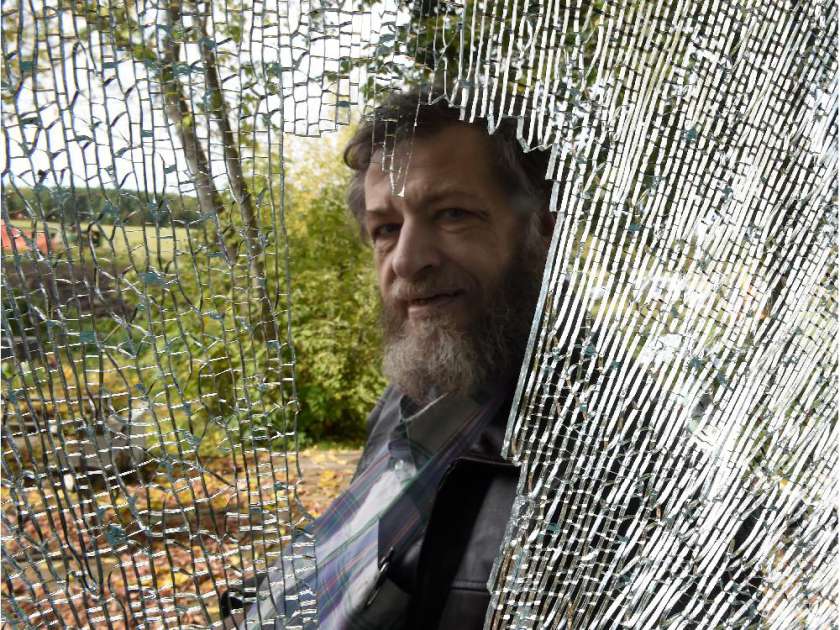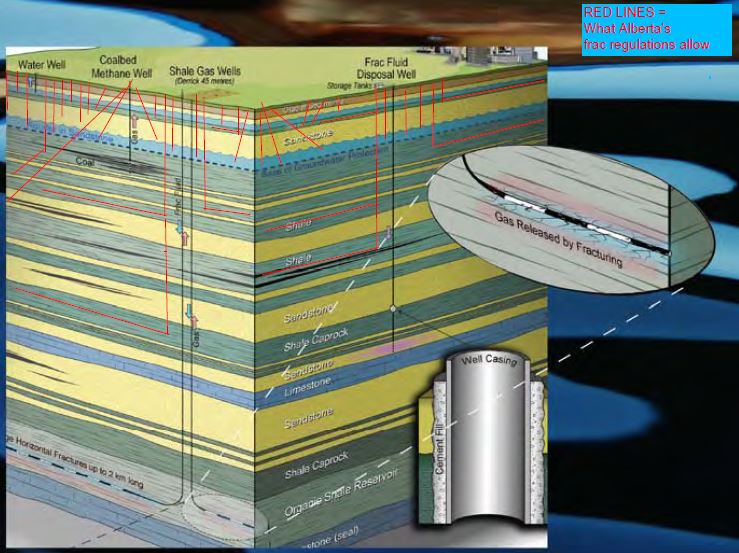A citizen who witnessed the March 15, 2012 AER (then ERCB) frac propaganda at Eagle Hill, reported that Bob Willard admitted he is not a frac expert and said (lied?) local fracs are no bigger than 10 to 20 thousand liters per well!
Edmonton-area fracking boom brings new life, new issues to old oilfields
http://edmontonjournal.com/news/local-news/controversial-devon-fracking-operation-uses-municipal-drinking-water
by Sheila Pratt, October 15, 2015, Edmonton Journal
Deep horizontal “fracking” wells could be a “game changer” for Alberta producers as they attempt to reverse the decline in production from old oilfields, according to an expert with the Alberta Energy Regulator.
Bob Willard, AER expert on fracking,
[Expert?
100% industry funded, legally immune, lying with “No duty of Care” and Enabling industry keeping toxic frac chemical secrets and poisoning Alberta families, and synergizing and lying and lying and lying and lying and lying and lying and lying and lying and lying makes him an “expert?”]
says the new types of wells go much deeper and use hydraulic fracturing — fluid injected under pressure — along horizontal wells to crack the rock and release the so-called “tight oil,” which can’t be reached by old vertical wells and pumpjacks.
So far, there are just a couple of dozen wells, but they are breathing new life into the oilfield near Devon, not far from the site of the province’s first big gusher in 1947.
What’s new in Devon area wells are the lengthy horizontal channels — up to 1,500 metres long — that use “multistage fracturing.” That means the rock is cracked at different intervals along the well bore. This allows the “tight oil” to flow to the surface.
As early as 2011, the federal government predicted a big impact for fracking in opening new supplies: “Tight oil has the potential to add significant light crude oil production that had not been anticipated just five years ago,” reads a federal report.
“And that’s exactly what’s happening,” says Willard.
Fracking has grown so quickly there’s now more oil coming from horizontal wells than old-style vertical wells topped with the pumpjacks that dot the rural landscape southwest of Edmonton.
Last year, new horizontal wells yielded 350,000 barrels, compared to 250,000 barrels from old, conventional vertical wells, said Willard.
“This is the new norm — 84 per cent of the new wells drilled were horizontal,” said Willard.
NEP Calgary has drilled about 20 wells in the area. The company employs about 50 people and a host of local contractors, according to an email from CEO Bud Newton.
Next door in Leduc County, more than a dozen companies have drilled 180 deep fracking wells for oil. Further west, in Brazeau County, more than 1,000 fracking wells have been drilled for oil, said Willard.
But the “fracking boom” is also bringing other issues to the surface — bigger, noisier drilling rigs, more wells on each site and sometimes controversially, the use of municipal drinking water for fracking, Willard added.
Fracking for oil uses a lot of water that can’t be recovered. Water mixed with special sand and chemicals is sent down the well at high pressure and pushed along the horizontal channels. The fluid stays in the rock to keep the cracks open.
Willard confirmed that the town of Devon is selling treated municipal water to NEP UCL, the company out of Calgary most active in the Devon area. That’s “not unique,” he said. Other municipalities also sell water to fracking companies.
While use of drinking water should be minimized, the regulator is neutral on the practice, Willard added. [He’s an expert?]
There are few options. Companies can apply to the regulator for a permit to withdraw water from a local lake or river or find a source of saline water — the preferred source — or negotiate with the municipality, he said. [So there’s no record of the water loss to Albertans?]
NEP uses about 2,500 cubic metres of water per well, he added.
Officials from the town of Devon, which gets its drinking water from the North Saskatchewan River, did not return calls on the issue, including how much water the town sells to the company. Devon has its own water treatment plant. [Town of Cochrane officials skirted the water issue also and downplayed it!]
Newton said that NEP strives to run an efficient operation and he noted that oil extraction is not the only industry in the area that needs a water supply. [But, fracing is the only industry that removes the water permanently from other use] “Just as other industries (such as refining, agriculture and electricity generation) we use water in our operations,” said Newton, adding that the company mostly uses third-party contractors to supply the water.
“NEP Canada strives to produce energy in a safe and efficient manner,” he added. “We want to be good neighbours to those around us and to the environment.”
Willard also noted that for Devon-area residents, fracking means more disruption than the old days when companies drilled a single well. Fracking sites have at least four wells.
“The duration and intensity is more than landowners are used to seeing; more wells, more trucks going in and out of a site,” said Willard.
[Let’s see what deep does:

Bob Willard, Senior advisor at the Alberta Energy Regulator, agreed to speak about current regulations.
David Kattenburg: Why aren’t these things being monitored for in the gases that are coming out from flaring and incineration stacks?
Bob: The long list that you’ve identified would be the responsibility for monitoring of not only the Alberta Energy Regulator, but the Environment department themselves, and I would direct you once again to ESRD for them to identify what their plans are relative to updating those guidelines.
David: I have actually, I’ve tried valiantly I’d say to try to get them to explain to me why they have these guidelines that say all industry MUST conform to these guidelines, and then I said well why does directive 60 of the Alberta Energy Regulator only establish monitoring requirements for sulfur dioxide and he said: “speak to the Alberta Energy Regulator.”
Bob: Um, it is important, and this is something the Energy Regulator does lead, is capturing the metrics of the volumes of material, so we do have good metrics as to the volumetrics.
David: But essentially nothing about the composition of those gases, other than sulfur dioxide.
Bob: A totally accurate composition, I would certainly volunteer that no, we do not have a totally accurate comprehensive information on the flare composition rather, we have it for the uh volumes, but not necessarily for the compositions.
***
ERCB (now AER) 2011 propaganda presented to the public and concerned landowners. The dotted blue line = the Base of Groundwater Protection. The red lines added by Ernst show what the AER allows, according to the regulator’s 100% industry funded, deregulating while lying to the public Directive 083:

The red lines indicate where oil and gas companies have and are fracing in Alberta. The dotted blue line = the Base of Groundwater Protection
